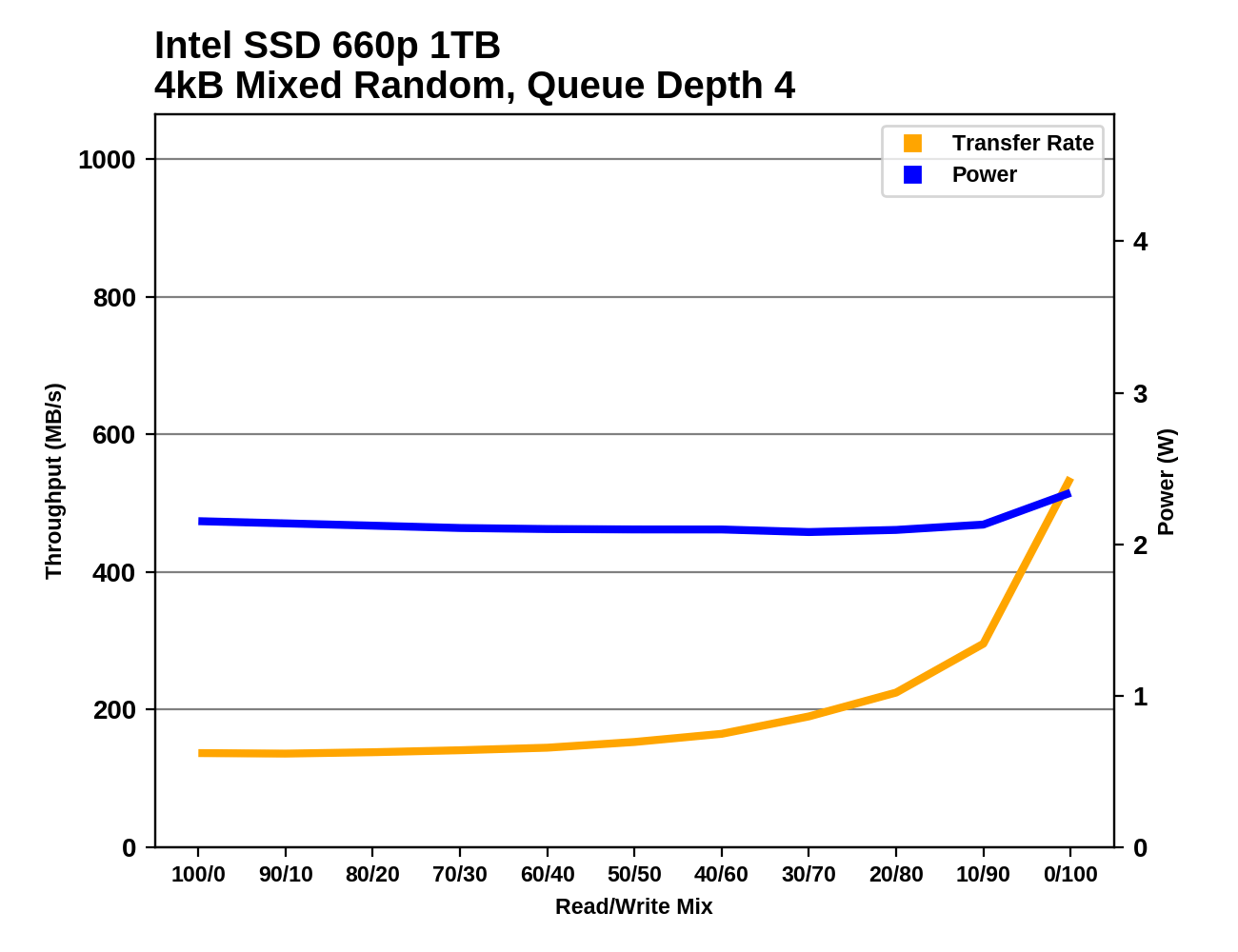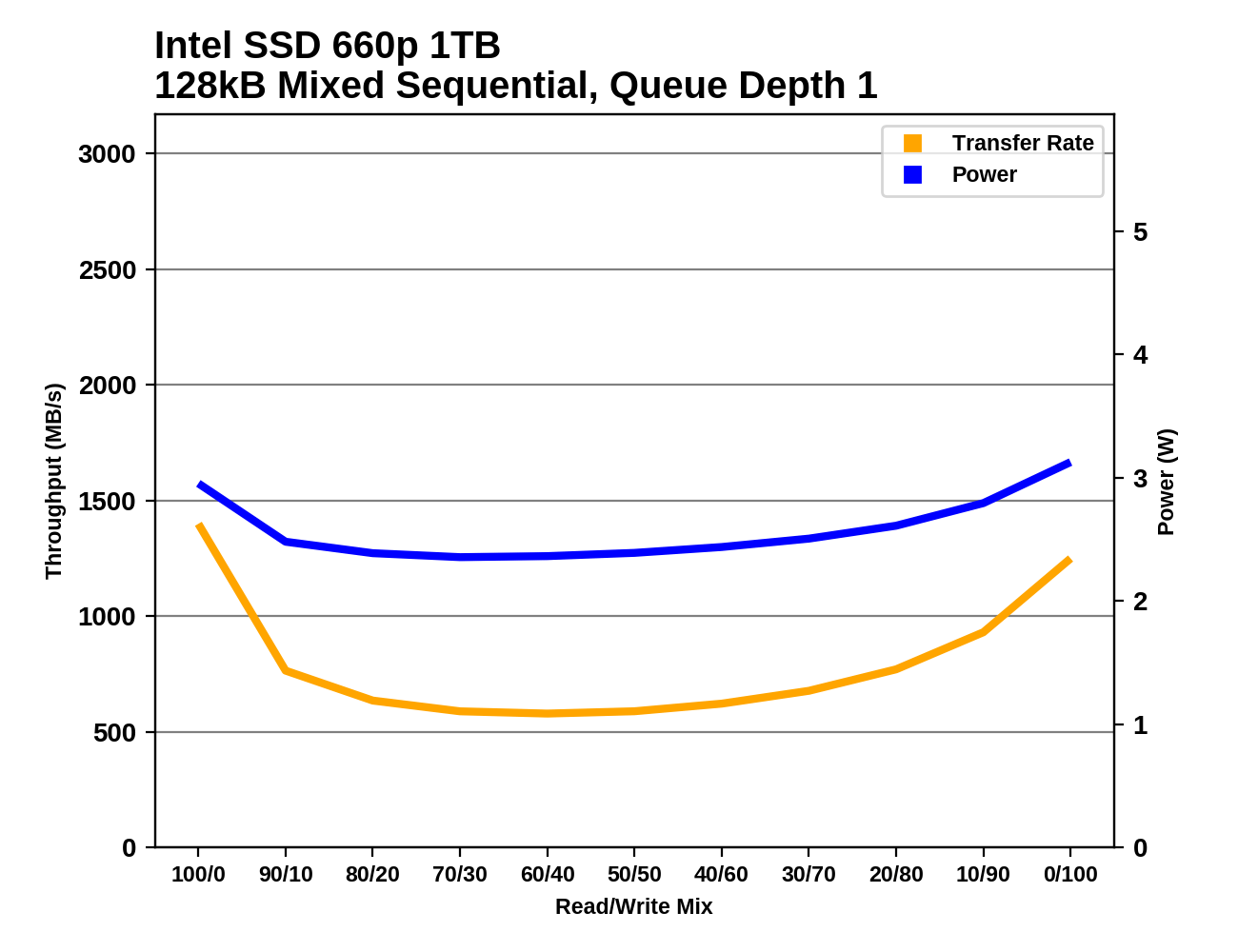The Intel SSD 660p SSD Review: QLC NAND Arrives For Consumer SSDs
by Billy Tallis on August 7, 2018 11:00 AM ESTMixed Random Performance
Our test of mixed random reads and writes covers mixes varying from pure reads to pure writes at 10% increments. Each mix is tested for up to 1 minute or 32GB of data transferred. The test is conducted with a queue depth of 4, and is limited to a 64GB span of the drive. In between each mix, the drive is given idle time of up to one minute so that the overall duty cycle is 50%.

The mixed random I/O performance of the Intel SSD 660p is clearly above the other low-end NVMe drives we've tested, or the Crucial MX500 SATA drive. It scores closer to a mid-range NVMe SSD. After filling the drive, performance is cut in half, leaving it performing near low-end NVMe drives like the Phison E8-based Kingston A1000 and below the MX500.
 |
|||||||||
| Power Efficiency in MB/s/W | Average Power in W | ||||||||
The power efficiency of the 660p during the mixed random I/O test is unimpressive but doesn't stand out as being significantly worse that other low-end NVMe drives even when the test is run on a full drive.
 |
|||||||||
The Intel SSD 660p shows very slow performance growth throughout most of the test, but it picks up speed reasonably well toward the end as the workload shifts toward pure writes, and the SLC cache handles things well. When the drive is full, the reduced capacity of the SLC cache prevents speed from increasing much.
Mixed Sequential Performance
Our test of mixed sequential reads and writes differs from the mixed random I/O test by performing 128kB sequential accesses rather than 4kB accesses at random locations, and the sequential test is conducted at queue depth 1. The range of mixes tested is the same, and the timing and limits on data transfers are also the same as above.

The Intel SSD 660p performs better than other entry-level NVMe SSDs or SATA drives when the mixed sequential I/O test is run on a mostly empty drive with a large SLC cache. After the drive is filled, performance drops down to slightly ahead of the 600p and Crucial MX500.
 |
|||||||||
| Power Efficiency in MB/s/W | Average Power in W | ||||||||
The power efficiency of the Intel SSD 660p during the mixed sequential I/O test is decent when operating entirely out of the SLC cache, and on par with most other low-end NVMe drives when the 660p is full.
 |
|||||||||
When the test is run on a mostly-empty 660p the performance shows a very typical bathtub curve and no sign of the SLC cache running out. When the drive is full, performance decreases steadily as the proportion of writes increases.










86 Comments
View All Comments
zodiacfml - Wednesday, August 8, 2018 - link
I think the limiting factor for reliability is the electronics/controller, not the NAND. You just lose drive space with a QLC much sooner with plenty of writes.romrunning - Wednesday, August 8, 2018 - link
Given that you can buy 1TB 2.5" HDD for $40-60 (maybe less for volume purchases), and even this QLC drive is still $0.20/GB, I think it's still going to be quite a while before notebook mfgs replace their "big" HDD with a QLC drive. After all, the first thing the consumer sees is "it's got lots of storage!"evilpaul666 - Wednesday, August 8, 2018 - link
Does the 660p series of drives work with the Intel CAS (Cache Acceleration Software)? I've used the trial version and it works about as well as Optane does for speeding up a mechanical HDD while being quite a lot larger.eddieobscurant - Wednesday, August 8, 2018 - link
Wow,this got a recommended award and the adata 8200 didn't. Another pro-intel marketing from anandtech. Waiting for biased threadripper 2 review.BurntMyBacon - Wednesday, August 8, 2018 - link
The performance of this SSD is quite bipolar. I'm not sure I'd be as generous with the award. Though, I think the decision to give out an award had more to do with the price of the drive and the probable performance for typical consumer workloads than some "pro-intel marketing" bias.danwat1234 - Wednesday, August 8, 2018 - link
The drive is only rated to write to each cell 200 times before it begins to wear out? Ewwww.azazel1024 - Wednesday, August 8, 2018 - link
For some consumer uses, yes 100MiB/sec constant write speed isn't terrible once the SLC cache is exhausted, but it'll probably be a no for me. Granted, SSD prices aren't where I want them to be yet to replace my HDDs for bulk storage. Getting close, but prices still need to come down by about a factor of 3 first.My use case is 2x1GbE between my desktop and my server and at some point sooner rather than later I'd like to go with 2.5GbE or better yet 5GbE. No, I don't run 4k video editing studio or anything like that, but yes I do occasionally throw 50GiB files across my network. Right now my network link is the bottleneck, though as my RAID0 arrays are filling up, it is getting to be disk bound (2x3TB Seagate 7200rpm drive arrays in both machines). And small files it definitely runs in to disk issues.
I'd like the network link to continue to be the limiting factor and not the drives. If I moved to a 2.5GbE link which can push around 270MiB/sec and I start lobbing large files, the drive steady state write limits are going to quickly be reached. And I really don't want to be running an SSD storage array in RAID. That is partly why I want to move to SSDs so I can run a storage pool and be confident that each individual SSD is sufficiently fast to at least saturate 2.5GbE (if I run 5GbE and the drives can't keep up, at least in an SLC cache saturated state, I am okay with that, but I'd like them to at least be able to run 250+ MiB/sec).
Also although rare, I've had to transfer a full back-up of my server or desktop to the other machine when I've managed to do something to kill the file copy (only happened twice over the last 3 years, but it HAS happened. Also why I keep a cold back-up that is updated every month or two on an external HDD). When you are transferring 3TiB or so of data, being limited to 100MiB/sec would really suck. At least right now when that happens I can push an average of 200MiB/sec (accounting for some of it being smaller files which are getting pushed at more like 80-140MiB/sec rather than the 235MiB/sec of large files).
That is a difference from close to 8:30 compared to about 4:15. Ideally I'd be looking at more like 3:30 for 3TiB.
But, then again, looking at price movement, unless I win the lottery, SSD prices are probably going to take at least 4 or more likely 5-6 years before I can drop my HDD array and just replace it with SSDs. Heck, odds are excellent I'll end up replacing my HDD array with a set of even faster 4 or 6TiB HDDs before SSDs are closer enough in price (closer enough to me is paying $1000 or less for 12TB of SSD storage).
That is keeping in mind that with HDDs I'd likely want utilized capacity under 75% and ideally under 67% to keep from utilizing those inner tracks and slowing way down. With SSDs (ignoring the SLC write cache size reductions), write penalties seem to be much less. Or at least the performance (for TLC and MLC) is so much higher than HDDs to start with, that it still remains high enough not to be a serious issue for me.
So an SSD storage pool could probably be up around 80-90% utilized and be okay, where as a HDD array is going to want to be no more than 67-75% utilized. And also in my use case, it should be easy enough to simply slap in another SSD to increase the pool size, with HDDs I'd need to chuck the entire array and get new sets of matched drives.
iwod - Wednesday, August 8, 2018 - link
On Mac, two weeks of normal usage has gotten 1TB of written data. And it does 10-15GB on average per day.100TB endurance is nothing.......
abufrejoval - Wednesday, August 8, 2018 - link
I wonder if underneath the algorithm has already changed to do what I’d call the ‘smart’ thing: Essentially QLC encoding is a way of compression (brings back old memories about “Stacker”) data 4:1 at the cost of write bandwidth.So unless you run out of free space, you first let all data be written in fast SLC mode and then start compressing things into QLC as a background activity. As long as the input isn’t constantly saturated, the compression should reclaim enough SLC mode blocks faster on average after compression than they are filled with new data. The bigger the overall capacity and remaining cache, the longer the burst it can sustain. Of course, once the SSD is completely filled the cache will be whatever they put into the spare area and updates will dwindle down to the ‘native’ QLC write rate of 100MB/s.
In a way this is the perfect storage for stuff like Steam games: Those tend to be hundreds of gigabytes these days, they are very sensitive to random reads (perhaps because the developers don’t know how to tune their data) but their maximum change rate is actually the capacity of your download bandwidth (wish mine was 100MB/s).
But it’s also great for data warehouse databases or quite simply data that is read-mostly, but likes high bandwidth and better latency than spinning disks.
The problem that I see, though, is that the compression pass needs power. So this doesn’t play well with mobile devices that you shut off immediately after slurping massive amounts of data. Worst case would be a backup SSD where you write and unplug.
The specific problem I see for Anandtech and technical writers is that you’re no longer comparing hardware but complex software. And Emil Post proved in 1946, that it’s generally impossible.
And with an MRAM buffer (those other articles) you could even avoid writing things at SLC first, as long as the write bursts do not overflow the buffer and QLC encoding empties it faster on average that it is filled. Should a burst overflow it, it could switch to SLC temporarily.
I think I like it…
And I think I would like it even better, if you could switch the caching and writing strategy at the OS or even application level. I don’t want to have to decide between buying a 2TB QLC, 1TB TLC, a 500GB MLC or 250GB SLC and then find out I need a little more here and a little less there. I have knowledge at the application (usage level), how long-lived my data will be and how it should best be treated: Let’s just use it, because the hardware internally is flexible enough to support at least SLC, TLC and QLC.
That would also make it easier to control the QLC rewrite or compression activity in mobile or portable form factors.
ikjadoon - Thursday, August 9, 2018 - link
Billy, thank you!I posted a reddit comment a long time ago about separating SSD performance by storage size! I might be behind, but this is the first I’ve seen of it. It’s, to me, a much more reliable graph for purchases.
A big shout out. 💪👌